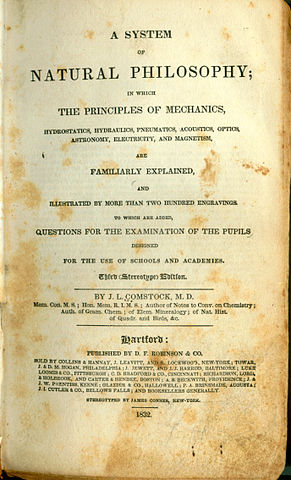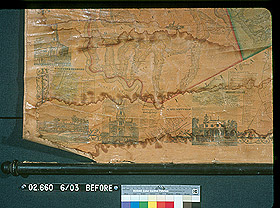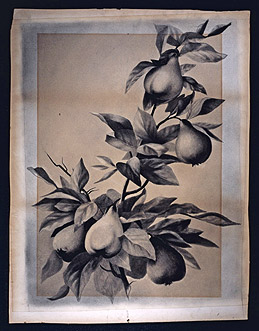
Evaluating your collections
1 Bound Materials | 2 Documents/Manuscripts/Ephemera | 3 Newsprint | 4 Oversized and Framed Materials
You have explored how the components of paper-based collections deteriorate, considered the complexities of some of the composite objects found in paper-based collections, and briefly examined the role of external factors in collection deterioration. Now you will begin to relate this information to your own collections.
IMPORTANT: This examination of your collections is not meant to serve as a formal collection condition survey, but it will assist you in determining which materials need further attention. You may decide that one or more collection condition surveys are required for specific subsets of your collection (e.g., rare books, photographs, scrapbooks). This type of inspection most often takes the form of an item-by-item survey by a conservator with detailed knowledge of that particular type of material.
1 Bound Materials
|
|
Bound materials in your collection may include printed books (general or rare), handwritten record books, and bound pamphlets of various types (e.g., catalogs, directories, guidelines).
Common types of physical damage to printed books and handwritten record books include page damage (e.g., tears, dog-eared corners, missing pages, markings from vandalism, damage from iron gall inks), binding damage (damaged sewing, detached signatures, deteriorating adhesives, broken or loose joints, wholly or partly detached covers, endcap damage), and distortion (caused by climate fluctuations or previous water damage). Older pamphlets are often very deteriorated due to handling and acidity, and may have been placed in acidic pamphlet binders to protect them.
Common types of chemical and biological damage include fading or darkening/discoloration of pages (due to light damage and acidity), acid migration from acidic inserts such as bookmarks, fading of binding materials, red rot of leather bindings, holes from insect damage, and staining caused by mold. Note that darkening of pages due to acidity often shows up first on the edges of the textblock, which are more exposed to pollutants and climate fluctuations.
2 Documents/Manuscripts/Ephemera
|
|
Documents and manuscripts found in cultural institutions can range from medieval manuscripts to 18th century letters to modern office files. They may be copies or originals, and they may have been produced using a variety of inks, papers, and copying processes. Ephemeral materials may include cards, postcards, brochures, patterns, papers dolls, etc., some of which may have raised surfaces or three-dimensional decoration, and may include adhesives.
Common physical damage to flat paper items includes tears, folds, and creases; dog-eared corners; abrasions; staining from rusted paper clips, deteriorated rubber bands, or pressure-sensitive tape; loss of parts of the paper (usually around the edges); and distortion and staining from previous water damage.
Common chemical and biological damage to paper documents includes brittleness and fragility due to acidic deterioration and light exposure; discoloration or darkening due to acidity and light exposure; staining and weakening from mold growth; holes from insect infestation; foxing (small brown spots that appear on paper, probably caused by mold or by the presence of tiny metal particles in the paper, in combination with high humidity and temperature); and acid migration, where better quality papers are stained by poor quality papers stored with them.
3 Newsprint
|
|
Newsprint is generally found in several formats within cultural collections: newspaper clippings within general document files, bound newspapers, loose newspapers, and newspaper clipping scrapbooks. Newsprint is almost uniformly made from poor quality paper and is usually very brittle, fragile, and darkened. Recent news clippings may still be in good condition, but they will ultimately be subject to the same deterioration processes. Clippings in scrapbooks may be further deteriorated due to the use of poor quality adhesives.
4 Oversized and Framed Materials
|
|
Most cultural collections include at least a few maps, plans, and architectural drawings. Perhaps they are maps of the surrounding area or plans of buildings within the institution. Many cultural institutions also hold collections of artwork on paper, which may include posters, watercolors, pastels, and drawings of various kinds.
In general, these materials are subject to the same types of deterioration as paper documents. Many of these materials are oversized and may have been stored rolled for many years, complicating the problems of acidic deterioration. If materials that have been rolled seem too brittle to unroll for examination without causing damage, do not unroll them; consult a conservator for assistance. You may also encounter maps or other items that have been coated with varnish or other coatings that have darkened and deteriorated.
|
|
As noted earlier in this session, various copying processes used for maps and architectural materials have different vulnerabilities, and different processes stored in proximity to each other may damage each other, resulting in discoloration or fading.
Artworks on paper also exhibit a range of deterioration problems, which include fading or alteration of watercolor pigments (such as yellows or blues); smearing of pastel, charcoal, or pencil drawings; yellowing, fading, or browning of the paper support due to acidic deterioration; foxing; surface mold growth; cockling due to climate fluctuations; and tide lines or stains due to water damage.
Framed materials (which might include artworks on paper, documents, or photographs) often show characteristic signs of deterioration: browning and yellowing due to acid migration from poor quality backing materials (these might be wood, corrugated board, newsprint, or cardboard); knot patterns or a dark central stripe down the paper due to wooden slats used in backing; mat burn (darkened lines around the margin where the beveled edge of acidic matboard meets the paper); tape stains due to poor quality tape used for repairs; and adhesive stains due to poor quality adhesives used to hinge or mount the item to the backboard.





